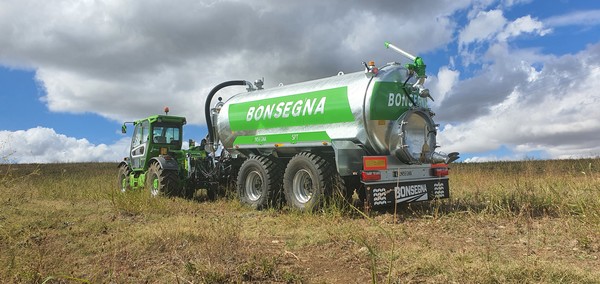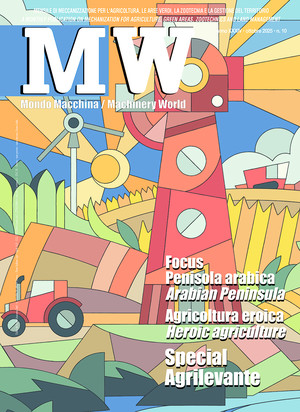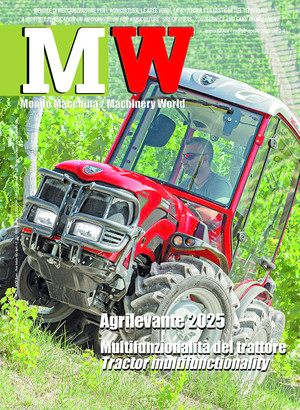
New technology for distributing livestock manure
The management of livestock manure is an opportunity to transform a by-product into a valuable resource. Technologies such as incorporation and umbilical systems reduce emissions and improve fertilizer efficiency, with an eye to business competitiveness and environmental protection
Livestock manure management is currently one of the most sensitive issues, undoubtedly strategic for the future of livestock farming. In fact, it is not about disposing of a "waste," but rather transforming what must be considered a by-product into a factor of production, that allows the farm to increase its sustainability and competitiveness on the market. Inefficient management of effluents has significant consequences: higher business costs, deterioration of soil fertility, and heavy environmental impacts on air, water, and land, and ultimately on the entire community.
At the company level, the main critical issues arise from the physical and chemical heterogeneity of effluents, which makes it difficult to standardize treatment, distribution, and fertilization efficiency, as well as from organizational inefficiencies, which often result in additional expenses due to the purchase of mineral fertilizers. On the environmental front, the repercussions are well known: with regard to the air, effluents release ammonia (NH3) and greenhouse gases such as methane (CH4), nitrous oxide (N2O), and carbon dioxide (CO2). These emissions contribute to acidification, climate change, and air pollution, as well as causing unpleasant odors. As for the soil, the accumulation of phosphorus and heavy metals can compromise long-term fertility and alter the chemical balance of the soil. Moreover, excessive amounts can cause anoxia (especially in heavy soils), as well as groundwater pollution and eutrophication in watercourses, with severe effects on aquatic ecosystems and water quality for civil use.
It is therefore not surprising that effluent management has long been regulated by a complex system of European, national, and regional regulations, starting with Directive 91/676/EEC (better known as the "Nitrates Directive," supplemented over the years by national directives and regional decrees), which sets limits on the agricultural use of effluents, establishing temporal (i.e., periods of prohibition of distribution), territorial (nitrates vulnerable zones), and quantitative (170–340 kg N/ha*year) constraints. These regulations have prompted farmers to make effluent management more efficient, particularly in the most environmentally sensitive areas, by adopting sustainable agricultural practices and an integrated approach that transforms effluents from a critical issue into a valuable resource. In addition to regulations, farmers face other practical constraints, namely: agronomic constraints, which require distribution to coincide with the crop stages when plants absorb the most nutrients; climatic constraints, linked to heavy rainfall or wet soil, which can reduce the window of opportunity for distribution, increasing the risk of compaction and runoff; logistical constraints, relating to the assessment of transport costs. In fact, once a certain distance between the storage and distribution sites is exceeded, the fertilizing value of the waste is no longer competitive with the cost of chemical fertilizer; technical constraints: for "virtuous" distribution, uniformity in the field, knowledge of the NPK content, control of the dose distributed, reduction of odorous emissions, and attention to soil compaction are required. Techniques and machinery for distributing livestock manure play an important role, especially in the latter aspect.
The solutions available vary according to the nature of the effluent to be distributed, distinguishing primarily between solid fractions (manure, poultry litter, solid digestates) and liquid fractions (slurry and liquid digestate fractions).
Machines for distributing solid effluents. Solid materials are distributed using manure spreaders. These machines can be equipped with different distribution systems, positioned at the rear (vertical/horizontal rotors, discs, or chains) or at the side (discs, rotors, or hoppers). The distribution phase must be followed by rapid incorporation, which limits ammoniacal nitrogen losses and preserves the fertilizing potential of the effluent. Technical data show that, compared to surface distribution without incorporation, intervention within 24 hours reduces emissions by 30%, while bringing it forward to 4 hours reduces emissions by 55%. In systems with simultaneous incorporation of the manure, the reduction can reach as much as 85-90%.
The working depth varies depending on the amount of manure spread: shallow (about 20 cm) for small amounts, deeper (30 cm) for larger amounts. It should be noted that, in this particular case, it is necessary to subject the effluent to pre-treatment (e.g., pelletization, extrusion, drying, or composting) in order to improve and standardize its physical properties, as it is highly heterogeneous and characterized by a high moisture content in its 'raw' state.
Machines for distributing liquid effluents. Slurry is distributed using towed or self-propelled slurry spreaders, or through umbilical systems that separate the transport phase from the application phase, significantly limiting soil compaction compared to the use of conventional carts.
Traditional surface techniques, such as the use of high-pressure sprinklers or deflector plates, are now considered obsolete because they cause serious nutrient losses (even over 80-90%), heavy odorous emissions, and uneven distribution. For this reason, they are not recommended, and their use is already subject to very strict legislative constraints.
On the contrary, ground-level solutions—using flexible hoses or deflectors—represent a significant step forward: they ensure better distribution uniformity, limit aerosol formation, reduce nitrogen losses by up to 60%, and can also be used on existing crops, avoiding contamination of the above-ground parts.
In any case, incorporation remains the most effective strategy for reducing emissions. Subsurface distribution in open or closed trenches allows the effluent to be applied in a targeted manner, reducing odors and ammonia losses by up to 80-90%. Closed trench systems, in particular, are very versatile because they combine distribution and tillage, facilitating subsequent operations, even allowing direct seeding through strip-tillage.
In any case, the choice of the optimal technique cannot be separated from overall agronomic management: the increase in the transport capacity of slurry tankers (over 30-35 t) has required greater attention to soil compaction: wide-section tires distributed over multiple axles, on-board pressure adjustment systems, offset axles and, above all, the adoption of umbilical systems are very effective solutions for reducing structural damage to the soil.
Umbilical systems for the distribution of livestock manure. These represent an innovative solution for the distribution of livestock manure, which is gradually gaining ground. It has been developed with the aim of increasing fertilization efficiency and reducing environmental impact: unlike traditional tankers, which require the continuous transport of slurry from storage points to the field by heavy vehicles, the umbilical system transfers the effluent - pressurized by a screw or centrifugal pump - directly from the central storage tank to the distribution point through a network of underground pipes. Here, using a flexible polyethylene or high-strength synthetic pipe laid out on the ground by a tractor-drawn reel, distribution takes place by means of the terminal device (diverter plate, drop bars with flexible pipes or deflectors, injectors followed by disc harrows, etc.), allowing for a calibrated and uniform release of the slurry, depending on the required nutrient dose.
The adoption of the umbilical system has several advantages.
First, it significantly reduces soil compaction, as it eliminates the need to move large volumes of slurry with wheeled tanks. In addition, it increases operational productivity: distribution is faster, more continuous, and consumes less fuel.
If the farm is not consolidated, systems with a “lagoon mobile” represent a modern and efficient solution for the distribution of livestock manure. With this technique, the slurry is transferred by shuttle tank from the main tank to a stationary support tank, called a "lagoon mobile” located at the edge of the field.
A constant reserve of slurry is maintained in the tank, which is then either sent under pressure to a tractor-drawn umbilical system with distribution similar to that described above, or taken from a small-capacity tanker that distributes it in the field. This option is preferred by contractors for its versatility, high working capacity, and optimization of time, consumption, and overall yield of fertilization operations.
Finally, in order to truly enhance the value of effluents from both an agronomic point of view and in terms of precision agriculture, it is essential to know their nutrient composition. Laboratory analyses provide useful average data, but are not always representative of temporal variations; for this reason, real-time indirect analysis systems are becoming increasingly popular, as they can be installed on slurry spreaders or at storage tanks. The technologies available today range from conductivity meters to NIR spectroscopy—which can estimate dry matter, nitrogen, phosphorus, and potassium with great accuracy—to nuclear magnetic resonance, a technique that is still in the experimental phase but promising.








